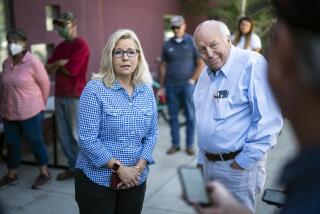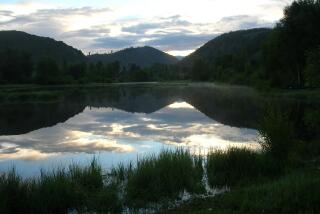Small-Town Roots Shaped Cheney
- Share via
CASPER, Wyo. — Dick Cheney’s apparently idyllic childhood in this rough-and-ready oil town unreels like a B-grade 1950s movie with a young Ronald Reagan in the starring role.
The small-town boy whose character was shaped by the contours of the bleak but productive landscape here learned self-reliance on these harsh plains and came to understand the value of hard work by living among ranchers.
Some say his bedrock conservatism was forged here, too, as he watched generations of locals strike it rich in Casper’s alluring oil fields, only to go broke as the town’s relentless economic boom-and-bust cycle played out. Cheerful, robust, determined and a little beat up--both Cheney and the town he grew up in have survived and, improbably, thrived.
Casper in the 1950s was an uncomplicated place where young people were allowed to flourish. Cheney was ensconced at the town’s only high school--Natrona County High. Photographs in successive yearbooks depict a beefy lad sporting a crew cut, a tight smile and, often, a tie. In four years he progressed from joining the Spanish Club to running a successful campaign as senior class president.
Casper was an easy place to be a kid. During the school year there were Friday night football games and chaste school mixers, followed by trips to the A&W.; Tuesday nights the kids met at the community center after the teenage girls were released from their club meetings.
Casper was a place, said David Nicholas, a Laramie attorney who was the best man at Cheney’s wedding, where there was “little opportunity to lead complicated lives. We were coming out of an age and place of innocence.”
Now a town with a population of about 49,000, with pressing issues of methamphetamine abuse, rising crime rates and a shrinking tax base, Casper still resonates with the small town wholesomeness. The Elks lodge marquee advertises a Shrimp Feed for the weekend, and it seems clear that many will happily attend.
It has never been simple. Casper has been required to be the stoutest of towns and has through the decades fought off drought, blizzards, a plague of grasshoppers and infernal federal interference with equal gusto. The town sprang up as the West and its treasures were being explored. Sitting at the confluence of a handful of major pioneer trails and possessing the first bridge across the Platte River, Casper became the hotelier, caterer and outfitter for any wagon train, prospector and outlaw heading west.
Then came the oil boom, which began in 1890 with the discovery of the Salt Lake field. With that, Casper’s history of infamy began. Although many here today scrunch their nose at the notion that Casper ever carried a naughty image, in fact the town’s reputation has always been colorful. One historian wrote that turn-of-the-century Casper was “noted for rustlers, thieves and bandits.”
Absurdly prosperous, Casper was known as the place where the poor were rich and the rich were richer. By 1915, oil companies were organizing and selling stock in bars and alleys on a daily basis, often illegally.
The oil boom ended in the late ‘20s but the town and its rowdy citizens continued to party as if money were still pumping out of the ground. Clustered near the river was the Sand Bar, a notorious red light district where, during Prohibition, shots of booze cost 75 cents and gambling was thriving.
Local politicians were loath to stamp out prostitution because the business--the most lucrative west of New Orleans--was adding so much money to town coffers.
Through the years Casper’s economy has continued to suffer the periodic pains experienced by the energy industry, even as the town and state have sought to establish a diversified economic base. Casper today is becoming a mecca for telephone calling centers, for example, drawn here for both the willing work force and the region’s unaccented American English.
It was in this spasmodic world of good and bad fortune that Cheney was reared. How he became the calm, even-keel bureaucrat that he is today comes, by all accounts, from the deep family roots of the community and his formidably solid parents.
Dick and his brother, Bob, and sister, Susan, grew up in a sturdy yellow and white wooden house on the eastern edge of town. To the west was the river. To the east the endless plains. Across the street sagebrush and jack rabbits.
Cheney rarely veered far from that ethos of plainness, working at the local five-and-dime after school and laboring on the football team, where for his exemplary work ethic he was elevated to co-captain. Like many things in his life, Cheney had been quietly good--not stellar, but solid.
“He was pretty stocky and he was slower than heck, but if he pointed himself at you, you’d better watch out,” said Joe Meyer, now Wyoming’s secretary of State and a teammate on the Natrona High football team.
While at Natrona, Cheney courted the school’s prettiest and smartest girl, Lynne Vincent. It was Lynne who has the couple’s more flamboyant history. Not only was she the Mustangs’ Homecoming Queen in 1959 but she was also a baton twirler of national note. In one particularly daring yearbook photo, young Lynne is seen maneuvering twin batons, each with their ends ablaze.
After graduation, Cheney admitted that he was unprepared when he and his high school buddy, Tom Fake, set out for Yale. Both young men would flunk out.
“We were small-town boys going to a big city,” Fake said. “We got there and we had never lived away from home. We didn’t want to admit it to ourselves, but we were homesick.”
To Todd Ennenga, executive director of the Casper Chamber of Commerce, leaving small Western towns to test yourself in the East or the big city has long been a rite of passage for young people in the region.
“I was born and raised here and when I left I worked for two Fortune 500 companies,” he said. “I think when you compete against people who had advantages you learn something about how you were raised. Out here, you learn resourcefulness. You hop in your car and go 200 miles to go to a rodeo or watch a high school football team, no big deal.”
Former Wyoming Sen. Malcolm Wallop, who served in Congress at the same time as Cheney, recalled a basic tenet of Wyoming politics: An elected public official, even one serving in Washington, is expected to return often, to remember names and the disposition of family members and even livestock.
If Cheney has been imbued with Casper’s sense of rugged inertia, it’s a trait often found in the populist West. Speaking of Cheney’s philosophy, David Nicholas was careful not to play up the image of the Noble Westerner, a God-fearing straight-shooter whose core values are more solid than the Rockies. The conservatism practiced by Cheney, he said, is not partisan.
“I’m not saying that we aren’t rock-ribbed conservative here, but I don’t see that as ideological. . . . I think it’s a much more thoughtful approach,” Nicholas said. “Here, there’s an openness, a plainness, a straightforwardness of viewpoint, a basic honesty.”
Cheney is clearly liked here, where last year the federal building was named in his honor. When Wednesday’s hastily planned appearance with George W. Bush was announced, by the end of the day Tuesday the town’s marquees, signboards and storefronts had been festooned with handmade signs proclaiming “Welcome Home Dick and Lynne.”
Even the Cheneys’ move to upscale and picturesque Jackson evoked minimal backlash, although people here are quick to say they don’t consider Jackson and its rich Hollywood part-timers as really part of the state.
“Well, they wear fur coats there, which pretty much says it all,” said Mary Ann Collins, Natrona County clerk. “No matter how long they live there, we’ll still consider Dick Cheney as being from Casper. He belongs to us.”
(BEGIN TEXT OF INFOBOX / INFOGRAPHIC)
Profile: Casper, Wyo.
Dick Cheney’s hometown is the second-largest city in Wyoming. Casper was settled on the banks of the Platte River in the mid-1800s. With all major westward trails--Oregon, Mormon, Bridger, Bozeman and Pony Express--converging there, the community developed as a crossroads to the West. Later, Casper boomed because of nearby oil, gas and uranium reserves. Today, Wyoming leads the nation in coal production.
*
Population: 49,131
Elevation: 5,123 ft.
Average temperatures in July: High 87.6, Low 54
Median family income: $33,366
Average cost of 2,000-sq.-ft. home: $160,000
Average one-way commute: 14 minutes
Slogan: “It’s Happening in Casper”
*
Notables from Casper:
* Former major league pitcher Tom Browning, who received his early experience in youth baseball there.
* Sharon Brondos, one of the few writers for Harlequin Novels who is published under her own name.
* Rodeo Hall of Famer Joe Alexander.
*
Sources: City of Casper, EPIC Relocation Services
*
Times staff writer Megan Garvey contributed to this story.
More to Read
Sign up for Essential California
The most important California stories and recommendations in your inbox every morning.
You may occasionally receive promotional content from the Los Angeles Times.













